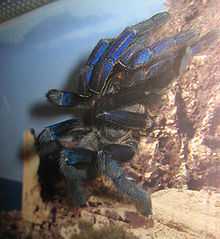Haplopelma
| Haplopelma | |
|---|---|
 | |
| Haplopelma lividum, Cobalt blue tarantula | |
| Scientific classification | |
| Kingdom: | Animalia |
| Phylum: | Arthropoda |
| Class: | Arachnida |
| Order: | Araneae |
| Suborder: | Mygalomorphae |
| Family: | Theraphosidae |
| Subfamily: | Ornithoctoninae |
| Genus: | Haplopelma Simon, 1892 |
| Species | |
|
H. albostriatum | |
| Diversity | |
| 11 species | |
| Synonyms | |
|
Melopoeus Pocock, 1895 | |
Haplopelma is a genus of old-world tarantula found in Southeast Asia. The range of this genus includes Myanmar, southeastern China, Cambodia, Thailand, Vietnam, Malaysia, Singapore, and Borneo.
Description
Haplopelma consists of relatively large specimens, with a typical adult legspan ranging from 4.5" to 6" (15 cm).[citation needed] The spiders all thrive in tropical environments, requiring humidity levels of up to 70% or more. They inhabit the tropical rain forests of southeast Asia, where they build and live in burrows up to several feet deep, emerging to capture food. These spiders prey on numerous small creatures, such as cockroaches, crickets, and mice.
Species
- Haplopelma albostriatum (Simon, 1886) — Myanmar, Thailand, Cambodia
- Haplopelma doriae (Thorell, 1890) — Borneo
- Haplopelma hainanum (Liang et al., 1999) — China
- Haplopelma lividum Smith, 1996 — Myanmar
- Haplopelma longipes von Wirth & Striffler, 2005 — Thailand, Cambodia
- Haplopelma minax (Thorell, 1897) — Myanmar, Thailand
- Haplopelma robustum Strand, 1907 — Singapore
- Haplopelma salangense (Strand, 1907) — Malaysia
- Haplopelma schmidti von Wirth, 1991 — Vietnam
- Haplopelma vonwirthi Schmidt, 2005 — Southeast Asia (possibly a misidentified H. minax.[1])
- Haplopelma sp. (Kambodscha) - Southeast Asia, Cambodian Black Earth Tiger
Medical significance
Like all old-world tarantulas, the spiders in Haploplema lack the urticating hairs found in their new world counterparts, and use biting as a primary means of defense. Those common in the pet trade are known as temperamental, difficult to care for, and likely to bite. While the venom of many of these species has not been studied, old world tarantulas are known for strong venom.
References
- ↑ http://www.striffler.net/papers/von_Wirth_&_Striffler_2005-Ornithoctonus_aureotibialis&Haplopelma_longipes.pdf VON WIRTH, V. & B. F. STRIFFLER (2005): Neue Erkenntnisse zur Vogelspinnen – Unterfamilie Ornithoctoninae, mit Beschreibung von Ornithoctonus aureotibialis sp. n. und Haplopelma longipes sp. n. (Araneae, Theraphosidae). Arthropoda 13(2): 2-27.